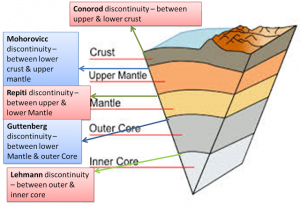ForumIAS announcing GS Foundation Program for UPSC CSE 2025-26 from 19 April. Click Here for more information.
ForumIAS Answer Writing Focus Group (AWFG) for Mains 2024 commencing from 24th June 2024. The Entrance Test for the program will be held on 28th April 2024 at 9 AM. To know more about the program visit: https://forumias.com/blog/awfg2024
Source: The post is based on the article “E prime layer: Surface Water Dives Deep And Transforms Earth’s Core’s Outer Layer” published in “Astrobiology” on 15th November 2023.
Why in the News?
Researchers from Arizona State University and an international team discovered the origin of the previously known E prime layer in the Earth’s interior, which until now remained a mystery.
What is the E prime layer?
The E prime layer is a distinct layer formed at the outermost part of Earth’s core. This layer is formed by surface water penetrating deep into the planet over billions of years.
Composition: It is a hydrogen-rich and silica-depleted layer.
How is the E prime layer formed?
Over billions of years, surface water has been transported deep into the Earth by descending tectonic plates.
Upon reaching the core-mantle boundary about 1,800 miles below the surface, this water chemically reacts with core materials.
This reaction leads to the formation of a hydrogen-rich, silicon-depleted layer at the outer core, resembling a film-like structure. This is known as the E prime layer.
The reaction also generates silica crystals which rise and integrate into the mantle, impacting the overall composition.
What is the significance of this study?
1) These findings also have significant implications in understanding Earth’s internal processes, heat generation and plate tectonics.
2) These findings point to a dynamic core-mantle interaction, suggesting substantial material exchange.
3) It also indicates a more extensive global water cycle than previously acknowledged.
What are the Various Layers in Earth’s Interior?

| Discontinuities | Transition zone between |
| Conrad Discontinuity | Upper crust and the lower crust |
| Mohorovicic Discontinuity | Crust and Mantle. |
| Repetti Discontinuity | Outer mantle and Inner mantle. |
| Gutenberg Discontinuity | Mantle and Core. |
| Lehmann Discontinuity | Outer core and Inner core. |
UPSC Syllabus: Geography




